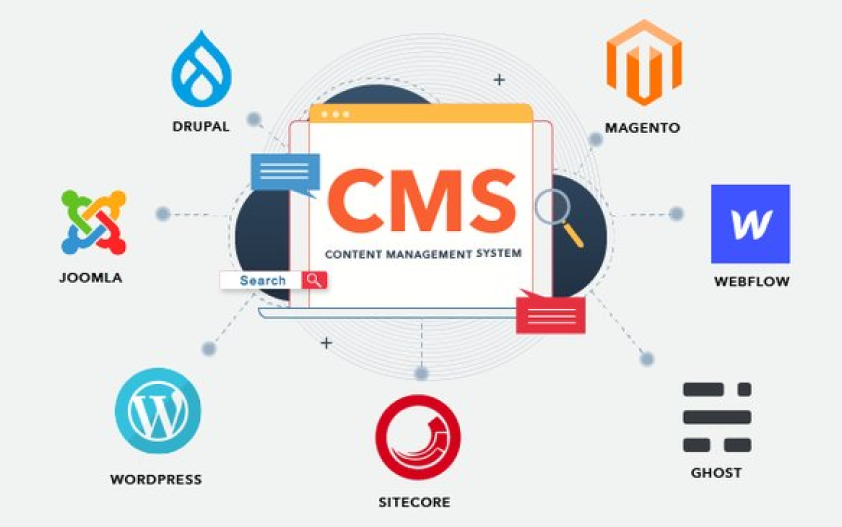Crafting the Perfect Content Management System (CMS)
Designing a Content Management System (CMS) within the realm of web technology involves several key components and considerations to ensure efficient content creation, storage, management, and delivery. Here’s an outline of the fundamental elements involved in designing a Content Management System:
1. User Interface (UI):
- Dashboard: A centralized control panel where users can manage content, including creating, editing, organizing, and publishing. The dashboard should be intuitive and easy to navigate, even for non-technical users. A clean UI and mobile responsiveness can improve accessibility for users on all devices. For more on responsive web design, check out this guide.
- Content Editor: An intuitive interface allowing users to input and format content easily. Rich text editors, WYSIWYG (What You See Is What You Get) editors, or structured content forms could be included.
2. Content Storage:
- Database: A database system to store various types of content, metadata, user information, and settings. Common choices include SQL (e.g., MySQL, PostgreSQL) or NoSQL databases (e.g., MongoDB, Firebase Firestore).
- File Storage: A method to manage and store media files, such as images, videos, and documents. Utilizing a content delivery network (CDN) might enhance the performance for delivering these files.
3. Content Model:
- Structured Content: Designing a Content Management System requires content models to define different content types (e.g., articles, pages, products) and their attributes. This could be implemented through schemas, taxonomies, or custom data models.
- Metadata: Incorporating metadata for better categorization, tagging, and searchability of content items.
4. User Management and Access Control:
- Authentication: Implementing user authentication and authorization mechanisms to control access levels and permissions for different user roles (e.g., admin, editor, contributor).
- User Profiles: Storing user information and preferences, enabling users to manage their profiles and settings.
5. SEO and Content Optimization:
- Integrating SEO tools into the CMS is crucial for ensuring that content is optimized for search engines. Specifically, features such as meta tag management, URL optimization, keyword suggestions, and automated sitemaps can be seamlessly incorporated to help boost content visibility. Additionally, these tools can make it easier to track and improve search engine ranking, ultimately increasing traffic and engagement.
6. Workflow and Version Control:
- Content Versioning: Allowing multiple versions of content items and providing the ability to revert to previous versions if needed.
- Workflow Automation: Implementing workflows for content approval, editing, and publishing processes. This involves defining states (draft, pending review, published) and transitions between these states.
7. Content Localization/Internationalization:
- A CMS should ideally support content in multiple languages or locales to cater to a global audience. This includes language switching capabilities, date and time formats, as well as translation support. Furthermore, localization can help tailor content to specific regions, providing a more personalized experience for users. Read more about internationalization in CMS design here.
8. Search and Indexing:
- Search Functionality: Integrating search features is essential to enable users to easily find relevant content. This may involve implementing full-text search, filters, and advanced search capabilities, thereby enhancing the user experience.
- Indexing: Moreover, employing indexing mechanisms can significantly optimize content retrieval and improve overall search performance. With efficient indexing, content becomes easier to find, improving the accessibility of information.
9. Performance and Scalability:
- Caching Strategies: Implementing caching mechanisms to improve system performance and reduce load times, utilizing techniques like page caching or object caching.
- Scalability: Designing the system with scalability in mind, considering factors such as database sharding, load balancing, and distributed architecture. Scalability ensures that as your website grows, your CMS can handle increased traffic and content without compromising performance.
10. Backup and Disaster Recovery:
- A reliable backup system is essential to ensure that data is not lost in case of an issue. Regular backups and a disaster recovery plan should be integrated into the CMS to prevent data loss and minimize downtime.
11. APIs and Integration:
- RESTful or GraphQL APIs: By providing APIs for third-party integrations, the CMS can enable external access to content and functionality, fostering flexibility in how content is consumed.
- Webhooks and Integrations: Furthermore, facilitating integrations with external services or tools, such as analytics, marketing automation, or e-commerce platforms, can enhance the CMS’s utility. This opens the door to automation, improving workflow efficiency across various functions.
12. Security:
- Data Encryption: Implementing encryption techniques to secure sensitive data, both in transit and at rest.
- Security Best Practices: Following industry-standard security practices to prevent common vulnerabilities such as SQL injection, XSS (Cross-Site Scripting), and CSRF (Cross-Site Request Forgery).
13. Analytics and Reporting:
- Data Tracking: Incorporating tools or modules for data tracking is essential in gathering insights into user behavior, content performance, and engagement metrics. This information can be crucial for making informed decisions.
- Reporting Dashboard: Additionally, providing users with a reporting dashboard helps monitor and analyze key metrics. By using services like Google Analytics or integrating custom reporting tools, users can gain valuable insights into engagement and content success, allowing them to optimize their strategy.
Conclusion:
In summary, a well-designed CMS system within web technology involves a comprehensive approach to managing content effectively, ensuring user-friendly interfaces, robust data storage, security measures, and seamless integrations to cater to diverse content creation and delivery needs. Flexibility, scalability, and user experience are pivotal factors in crafting an efficient CMS solution. By considering these core components, you can build a CMS that is secure, scalable, and user-centric.

